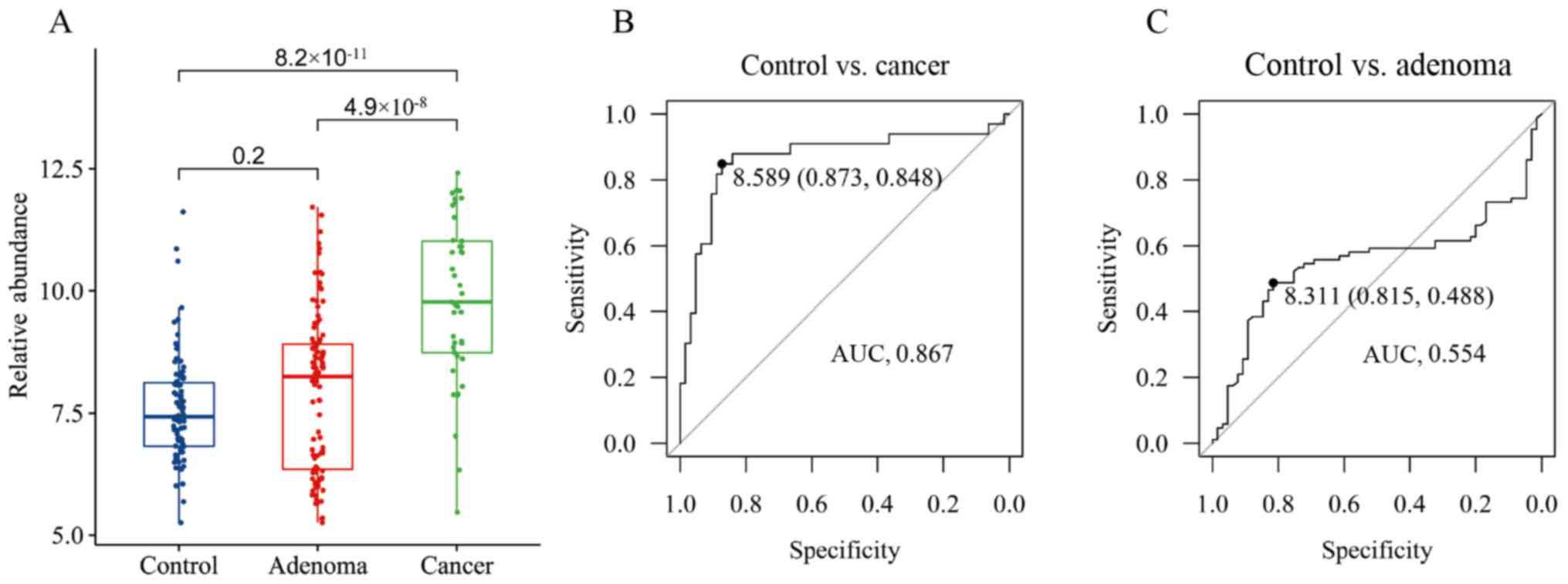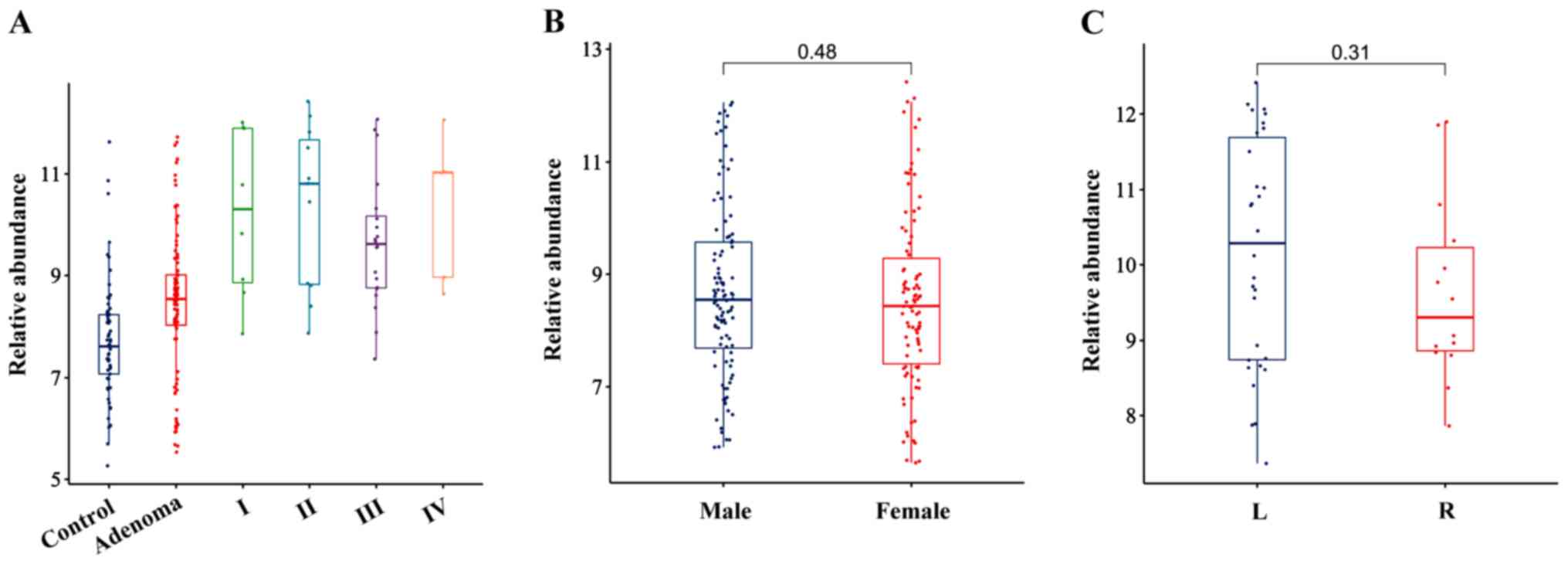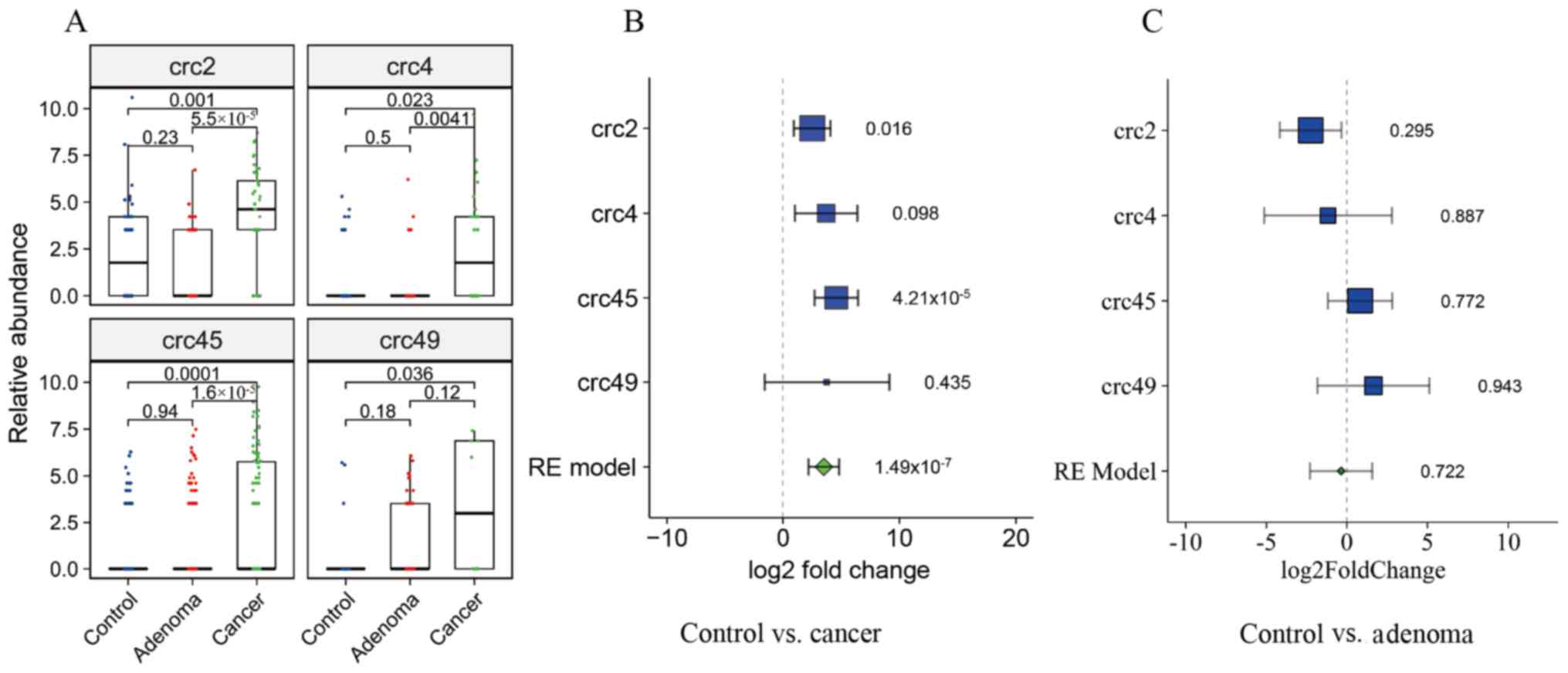|
1
|
Dekker E, Tanis PJ, Vleugels JLA, Kasi PM
and Wallace MB: Colorectal cancer. Lancet. 394:1467–1480. 2019.
View Article : Google Scholar : PubMed/NCBI
|
|
2
|
Yu J, Feng Q, Wong SH, Zhang D, Liang QY,
Qin Y, Tang L, Zhao H, Stenvang J, Li Y, et al: Metagenomic
analysis of faecal microbiome as a tool towards targeted
non-invasive biomarkers for colorectal cancer. Gut. 66:70–78. 2017.
View Article : Google Scholar : PubMed/NCBI
|
|
3
|
Louis P, Hold GL and Flint HJ: The gut
microbiota, bacterial metabolites and colorectal cancer. Nat Rev
Microbiol. 12:661–672. 2014. View Article : Google Scholar : PubMed/NCBI
|
|
4
|
Niederreiter L, Adolph TE and Tilg H:
Food, microbiome and colorectal cancer. Dig Liver Dis. 50:647–652.
2018. View Article : Google Scholar : PubMed/NCBI
|
|
5
|
Saus E, Iraola-Guzmán S, Willis JR,
Brunet-Vega A and Gabaldón T: Microbiome and colorectal cancer:
Roles in carcinogenesis and clinical potential. Mol Aspects Med.
69:93–106. 2019. View Article : Google Scholar : PubMed/NCBI
|
|
6
|
De Almeida CV, de Camargo MR, Russo E and
Amedei A: Role of diet and gut microbiota on colorectal cancer
immunomodulation. World J Gastroenterol. 25:151–162. 2019.
View Article : Google Scholar : PubMed/NCBI
|
|
7
|
Gagnière J, Raisch J, Veziant J, Barnich
N, Bonnet R, Buc E, Bringer MA, Pezet D and Bonnet M: Gut
microbiota imbalance and colorectal cancer. World J Gastroenterol.
22:501–518. 2016. View Article : Google Scholar : PubMed/NCBI
|
|
8
|
Zackular JP, Rogers MA, Ruffin MT IV and
Schloss PD: The human gut microbiome as a screening tool for
colorectal cancer. Cancer Prev Res (Phila). 7:1112–1121. 2014.
View Article : Google Scholar : PubMed/NCBI
|
|
9
|
Wong SH, Zhao L, Zhang X, Nakatsu G, Han
J, Xu W, Xiao X, Kwong TNY, Tsoi H, Wu WKK, et al: Gavage of fecal
samples from patients with colorectal cancer promotes intestinal
carcinogenesis in germ-free and conventional mice.
Gastroenterology. 153:1621–1633.e6. 2017. View Article : Google Scholar : PubMed/NCBI
|
|
10
|
Baghban A and Gupta S: Parvimonas
micra: A rare cause of native joint septic arthritis. Anaerobe.
39:26–27. 2016. View Article : Google Scholar : PubMed/NCBI
|
|
11
|
Khan MS, Ishaq M, Hinson M, Potugari B and
Rehman AU: Parvimonas micra bacteremia in a patient with
colonic carcinoma. Caspian J Intern Med. 10:472–475.
2019.PubMed/NCBI
|
|
12
|
Yun SS, Cho HS, Heo M, Jeong JH, Lee HR,
Ju S, Kim JY, You JW, Cho YJ, Jeong YY, et al: Lung abscess by
actinomyces odontolyticus and Parvimonas micra co-infection
presenting as acute respiratory failure: A case report. Medicine
(Baltimore). 98:e169112019. View Article : Google Scholar : PubMed/NCBI
|
|
13
|
Coker OO, Dai Z, Nie Y, Zhao G, Cao L,
Nakatsu G, Wu WK, Wong SH, Chen Z, Sung JJY and Yu J: Mucosal
microbiome dysbiosis in gastric carcinogenesis. Gut. 67:1024–1032.
2018. View Article : Google Scholar : PubMed/NCBI
|
|
14
|
Sawai T, Koga S, Ide S, Yoshioka S, Matsuo
N and Mukae H: An iliopsoas abscess caused by Parvimonas
micra: A case report. J Med Case Rep. 13:472019. View Article : Google Scholar : PubMed/NCBI
|
|
15
|
Baxter NT, Koumpouras CC, Rogers MA,
Ruffin MT IV and Schloss PD: DNA from fecal immunochemical test can
replace stool for detection of colonic lesions using a
microbiota-based model. Microbiome. 4:592016. View Article : Google Scholar : PubMed/NCBI
|
|
16
|
Zhang Y, Yu X, Yu E, Wang N, Cai Q, Shuai
Q, Yan F, Jiang L, Wang H, Liu J, et al: Changes in gut microbiota
and plasma inflammatory factors across the stages of colorectal
tumorigenesis: A case-control study. BMC Microbiol. 18:922018.
View Article : Google Scholar : PubMed/NCBI
|
|
17
|
Baxter NT, Ruffin MT IV, Rogers MA and
Schloss PD: Microbiota-based model improves the sensitivity of
fecal immunochemical test for detecting colonic lesions. Genome
Med. 8:372016. View Article : Google Scholar : PubMed/NCBI
|
|
18
|
Wong SH, Kwong TNY, Chow TC, Luk AKC, Dai
RZW, Nakatsu G, Lam TYT, Zhang L, Wu JCY, Chan FKL, et al:
Quantitation of faecal Fusobacterium improves faecal
immunochemical test in detecting advanced colorectal neoplasia.
Gut. 66:1441–1448. 2017. View Article : Google Scholar : PubMed/NCBI
|
|
19
|
Wirbel J, Pyl PT, Kartal E, Zych K,
Kashani A, Milanese A, Fleck JS, Voigt AY, Palleja A, Ponnudurai R,
et al: Meta-analysis of fecal metagenomes reveals global microbial
signatures that are specific for colorectal cancer. Nat Med.
25:679–689. 2019. View Article : Google Scholar : PubMed/NCBI
|
|
20
|
Thomas AM, Manghi P, Asnicar F, Pasolli E,
Armanini F, Zolfo M, Beghini F, Manara S, Karcher N, Pozzi C, et
al: Metagenomic analysis of colorectal cancer datasets identifies
cross-cohort microbial diagnostic signatures and a link with
choline degradation. Nat Med. 25:667–678. 2019. View Article : Google Scholar : PubMed/NCBI
|
|
21
|
Castellarin M, Warren RL, Freeman JD,
Dreolini L, Krzywinski M, Strauss J, Barnes R, Watson P,
Allen-Vercoe E, Moore RA and Holt RA: Fusobacterium
nucleatum infection is prevalent in human colorectal carcinoma.
Genome Res. 22:299–306. 2012. View Article : Google Scholar : PubMed/NCBI
|
|
22
|
Valcz G, Sipos F, Krenács T, Molnár J,
Patai AV, Leiszter K, Tóth K, Solymosi N, Galamb O, Molnár B and
Tulassay Z: Elevated osteopontin expression and
proliferative/apoptotic ratio in the colorectal
adenoma-dysplasia-carcinoma sequence. Pathol Oncol Res. 16:541–545.
2010. View Article : Google Scholar : PubMed/NCBI
|
|
23
|
Sze MA and Schloss PD: Leveraging existing
16S rRNA gene surveys to identify reproducible biomarkers in
individuals with colorectal tumors. mBio. 9:e00630–18. 2018.
View Article : Google Scholar : PubMed/NCBI
|
|
24
|
Zhang B, Xu S, Xu W, Chen Q, Chen Z, Yan
C, Fan Y, Zhang H, Liu Q, Yang J, et al: Leveraging fecal bacterial
survey data to predict colorectal tumors. Front Genet. 10:4472019.
View Article : Google Scholar : PubMed/NCBI
|
|
25
|
Shah MS, DeSantis TZ, Weinmaier T,
McMurdie PJ, Cope JL, Altrichter A, Yamal JM and Hollister EB:
Leveraging sequence-based faecal microbial community survey data to
identify a composite biomarker for colorectal cancer. Gut.
67:882–891. 2018. View Article : Google Scholar : PubMed/NCBI
|
|
26
|
Russo E, Bacci G, Chiellini C, Fagorzi C,
Niccolai E, Taddei A, Ricci F, Ringressi MN, Borrelli R, Melli F,
et al: Preliminary comparison of oral and intestinal human
microbiota in patients with colorectal cancer: A pilot study. Front
Microbiol. 8:26992018. View Article : Google Scholar : PubMed/NCBI
|
|
27
|
Sheng Q, Du H, Cheng X, Cheng X, Tang Y,
Pan L, Wang Q and Lin J: Characteristics of fecal gut microbiota in
patients with colorectal cancer at different stages and different
sites. Oncol Lett. 18:4834–4844. 2019.PubMed/NCBI
|
|
28
|
Livak KJ and Schmittgen TD: Analysis of
relative gene expression data using real-time quantitative PCR and
the 2(-Delta Delta C(T)) method. Methods. 25:402–408. 2001.
View Article : Google Scholar : PubMed/NCBI
|
|
29
|
Zeller G, Tap J, Voigt AY, Sunagawa S,
Kultima JR, Costea PI, Amiot A, Böhm J, Brunetti F, Habermann N, et
al: Potential of fecal microbiota for early-stage detection of
colorectal cancer. Mol Syst Biol. 10:7662014. View Article : Google Scholar : PubMed/NCBI
|
|
30
|
Mori G, Rampelli S, Orena BS, Rengucci C,
De Maio G, Barbieri G, Passardi A, Casadei Gardini A, Frassineti
GL, Gaiarsa S, et al: Shifts of faecal microbiota during sporadic
colorectal carcinogenesis. Sci Rep. 8:103292018. View Article : Google Scholar : PubMed/NCBI
|
|
31
|
Masella AP, Bartram AK, Truszkowski JM,
Brown DG and Neufeld JD: PANDAseq: Paired-end assembler for
illumina sequences. BMC Bioinformatics. 13:312012. View Article : Google Scholar : PubMed/NCBI
|
|
32
|
Bolger AM, Lohse M and Usadel B:
Trimmomatic: A flexible trimmer for Illumina sequence data.
Bioinformatics. 30:2114–2120. 2014. View Article : Google Scholar : PubMed/NCBI
|
|
33
|
Rognes T, Flouri T, Nichols B, Quince C
and Mahé F: VSEARCH: A versatile open source tool for metagenomics.
PeerJ. 4:e25842016. View Article : Google Scholar : PubMed/NCBI
|
|
34
|
Caporaso JG, Kuczynski J, Stombaugh J,
Bittinger K, Bushman FD, Costello EK, Fierer N, Peña AG, Goodrich
JK, Gordon JI, et al: QIIME allows analysis of high-throughput
community sequencing data. Nat Methods. 7:335–336. 2010. View Article : Google Scholar : PubMed/NCBI
|
|
35
|
Edgar RC: Search and clustering orders of
magnitude faster than BLAST. Bioinformatics. 26:2460–2461. 2010.
View Article : Google Scholar : PubMed/NCBI
|
|
36
|
Quast C, Pruesse E, Yilmaz P, Gerken J,
Schweer T, Yarza P, Peplies J and Glöckner FO: The SILVA ribosomal
RNA gene database project: Improved data processing and web-based
tools. Nucleic Acids Res. 41((Database Issue)): D590–D596.
2013.PubMed/NCBI
|
|
37
|
Griffen AL, Beall CJ, Firestone ND, Gross
EL, Difranco JM, Hardman JH, Vriesendorp B, Faust RA, Janies DA and
Leys EJ: CORE: A phylogenetically-curated 16S rDNA database of the
core oral microbiome. PLoS One. 6:e190512011. View Article : Google Scholar : PubMed/NCBI
|
|
38
|
Liang JQ, Li T, Nakatsu G, Chen YX, Yau
TO, Chu E, Wong S, Szeto CH, Ng SC, Chan FKL, et al: A novel faecal
lachnoclostridium marker for the non-invasive diagnosis of
colorectal adenoma and cancer. Gut. 69:1248–1257. 2020. View Article : Google Scholar : PubMed/NCBI
|
|
39
|
Paulson JN, Stine OC, Bravo HC and Pop M:
Differential abundance analysis for microbial marker-gene surveys.
Nat Methods. 10:1200–1202. 2013. View Article : Google Scholar : PubMed/NCBI
|
|
40
|
Viechtbauer W: Conducting meta-analyses in
R with the metafor package. J Stat Softw. 36:1–48. 2010. View Article : Google Scholar
|
|
41
|
Love MI, Huber W and Anders S: Moderated
estimation of fold change and dispersion for RNA-seq data with
DESeq2. Genome Biol. 15:5502014. View Article : Google Scholar : PubMed/NCBI
|
|
42
|
Robin X, Turck N, Hainard A, Tiberti N,
Lisacek F, Sanchez JC and Müller M: pROC: An open-source package
for R and S+ to analyze and compare ROC curves. BMC Bioinformatics.
12:772011. View Article : Google Scholar : PubMed/NCBI
|
|
43
|
Wickham H: ggplot2: Elegant Graphics for
Data Analysis. Springer-Verlag. (New York, NY). 2016.
|
|
44
|
Alboukadel K: ggpubr: ‘ggplot2’ based
publication ready plots. R package version 0.4.0. 2018.
|
|
45
|
Sears CL and Pardoll DM: Perspective:
Alpha-bugs, their microbial partners, and the link to colon cancer.
J Infect Dis. 203:306–311. 2011. View Article : Google Scholar : PubMed/NCBI
|
|
46
|
Vogelstein B and Kinzler KW: The multistep
nature of cancer. Trends Genet. 9:138–141. 1993. View Article : Google Scholar : PubMed/NCBI
|
|
47
|
Fearon ER: Molecular genetics of
colorectal cancer. Annu Rev Pathol. 6:479–507. 2011. View Article : Google Scholar : PubMed/NCBI
|
|
48
|
Tjalsma H, Boleij A, Marchesi JR and
Dutilh BE: A bacterial driver-passenger model for colorectal
cancer: Beyond the usual suspects. Nat Rev Microbiol. 10:575–582.
2012. View Article : Google Scholar : PubMed/NCBI
|
|
49
|
Amitay EL, Werner S, Vital M, Pieper DH,
Höfler D, Gierse IJ, Butt J, Balavarca Y, Cuk K and Brenner H:
Fusobacterium and colorectal cancer: Causal factor or passenger?
Results from a large colorectal cancer screening study.
Carcinogenesis. 38:781–788. 2017. View Article : Google Scholar : PubMed/NCBI
|
|
50
|
Mizutani S, Yamada T and Yachida S:
Significance of the gut microbiome in multistep colorectal
carcinogenesis. Cancer Sci. 111:766–773. 2020. View Article : Google Scholar : PubMed/NCBI
|
|
51
|
Yachida S, Mizutani S, Shiroma H, Shiba S,
Nakajima T, Sakamoto T, Watanabe H, Masuda K, Nishimoto Y, Kubo M,
et al: Metagenomic and metabolomic analyses reveal distinct
stage-specific phenotypes of the gut microbiota in colorectal
cancer. Nat Med. 25:968–976. 2019. View Article : Google Scholar : PubMed/NCBI
|
|
52
|
Horiuchi A, Kokubu E, Warita T and
Ishihara K: Synergistic biofilm formation by Parvimonas
micra and Fusobacterium nucleatum. Anaerobe.
62:1021002020. View Article : Google Scholar : PubMed/NCBI
|
|
53
|
Neilands J, Davies JR, Bikker FJ and
Svensäter G: Parvimonas micra stimulates expression of
gingipains from Porphyromonas gingivalis in multi-species
communities. Anaerobe. 55:54–60. 2019. View Article : Google Scholar : PubMed/NCBI
|
|
54
|
Marchesan J, Jiao Y, Schaff RA, Hao J,
Morelli T, Kinney JS, Gerow E, Sheridan R, Rodrigues V, Paster BJ,
et al: TLR4, NOD1 and NOD2 mediate immune recognition of putative
newly identified periodontal pathogens. Mol Oral Microbiol.
31:243–258. 2016. View Article : Google Scholar : PubMed/NCBI
|
|
55
|
Ge W, Hu H, Cai W, Xu J, Hu W, Weng X, Qin
X, Huang Y, Han W, Hu Y, et al: High-risk stage III colon cancer
patients identified by a novel five-gene mutational signature are
characterized by upregulation of IL-23A and gut bacterial
translocation of the tumor microenvironment. Int J Cancer.
146:2027–2035. 2020. View Article : Google Scholar : PubMed/NCBI
|
|
56
|
Yu J, Zhao LY, Zhao RS, Long XH, Coker O
and Sung JJY: The role of Parvimonas micra in intestinal
tumorigenesis in germ-free and conventional APCmin/+
mice. J Clin Oncol. 37 (Suppl 4):S5312019. View Article : Google Scholar
|

















